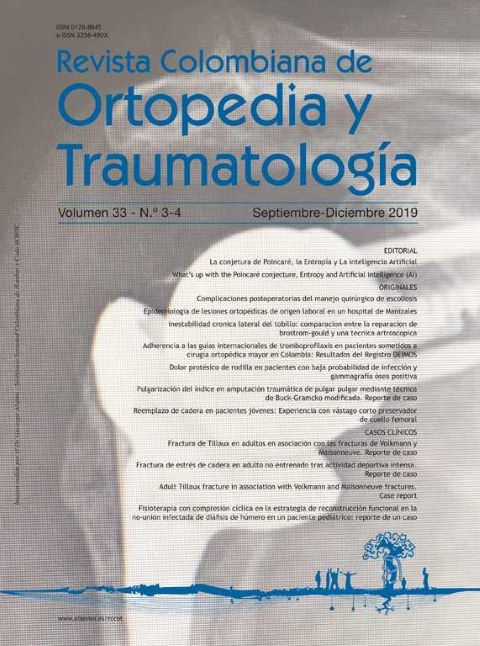Fisioterapia con compresión cíclica en la estrategia de reconstrucción funcional en la no-unión infectada de diáfisis de húmero en un paciente pediátrico: reporte de un caso
DOI:
https://doi.org/10.1016/j.rccot.2020.02.009Palabras clave:
no-unión, fractura, diáfisis húmero, colgajo pediculado, fisioterapia, compresión, foco de fractura, pérdida óseaResumen
Introducción: Las fracturas de humero diafisiarias abarcan del 5% de todas las fracturas del cuerpo humano. La infección asociada a la no-unión de humero en niños es una patología extremadamente rara e incapacitante, que de no ser tratada adecuadamente puede comprometer de manera definitiva la función de toda la extremidad.</abstract>
Reporte de Caso: Se reporta el caso de un paciente masculino de 9 años de edad quien consulta a nuestra institución con la no-unión infectada de humero izquierdo, asociado a pérdida de sustancia ósea, muscular y cutánea, con lesión del nervio radial y con una nula funcionalidad de la extremidad. Se plantea una estrategia de reconstrucción en 5 fases y se presenta el uso de terapias de compresión cíclica como factor clave para la consolidación de la fractura.
Discusión: En este caso complejo y poco común, se cumplieron todos los objetivos propuestos en el tratamiento de una no-unión infectada, la erradicación de la infección con la adecuada consolidación ósea, recuperación funcional y estética en un lapso de 10 meses.
Nivel de Evidencia: IV
Descargas
Referencias bibliográficas
Jupiter JB, vonDec kM. Ununited humeral diaphyses. JShoulder ElbowSurg. 1998;7:644-53. https://doi.org/10.1016/S1058-2746(98)90016-7
Patel VR, Menon DK, Pool RD, Simons RB. No union of the humerus afther failure of surgical treatment. J bone joint SURG BR. 2000;83:977-83. https://doi.org/10.1302/0301-620X.82B7.0820977
Ekholm R, Adami J, Tidermark J, et al. Fractures of the shaft of the humerus An epidemiological study of 401 fractures. J Bone Joint Surg Br. 2006;88:1469-73. https://doi.org/10.1302/0301-620X.88B11.17634
Pullen C1, Manzotti A, Catagni MA, Guerreschi F. Treatment of post-traumatic humeral diaphyseal nonunion with bone loss.
Müller ME, Allgöwer M, Schneider R. Manual of Internal Fixation: Techniques Recommended by the AO Group. Berlin SpringerVerlag. 1979. https://doi.org/10.1007/978-3-642-96505-0
Delayed unión and nounion of fracture. In crenshaw,AH., ed. Campbell's operative orthopaedics, 8th ed. St, Louis, MO, Mosby 1992, pp 1287-1345.
Brinker Mark R, Daniel P. O'Connor, CHAPTER 22 Nonunions: Evaluation and Treatment; Browner, 978-1-4160-2220-6.
Harley BJ, Beaupre LA, Jones CA, et al. The effect of time to definitive treatment on the rate of nonunion and infection in open fractures. J Orthop Trauma. 2002;16:484-90. https://doi.org/10.1097/00005131-200208000-00006
Fritton SP, McLeod KJ, Rubin CT. Quantifying the strain history of bone: spatial uniformity and self-similarity of low-magnitude strains. J Biomech. 2000;33:317-25. https://doi.org/10.1016/S0021-9290(99)00210-9
Raikin SM, Landsman JC, Alexander VA, et al. Effect of nicotine on the rate and strength of long bone fracture healing. Clin Orthop Relat Res. 1998;353:231-7. https://doi.org/10.1097/00003086-199808000-00027
Jain AK, Shina S:. Infected nonunion of the long bones. Clin Orthop Relat Res. 2005;431:57-65. https://doi.org/10.1097/01.blo.0000152868.29134.92
Court-Brown CM, McQueen M. Nonunions of the proximal humerus: their prevalence and functional outcome. J Trauma. 2008;64:21-1517. https://doi.org/10.1097/TA.0b013e3181469840
Fitzgerald RH, Ruttle PE, Arnold PG, Kelly PJ, Irons BG. Local muscle flap in the treatment of the chronic osteomielitis. J Bone Joint Surg Am. 1985;67:175. https://doi.org/10.2106/00004623-198567020-00001
Piekarski K. Transport mechanism operating between blood supply and osteo- cytes in long bones. Nature. 1977;269:80-2. https://doi.org/10.1038/269080a0
Hert J, Liskova M, Landa J. Reaction of bone to mechanical stimuli 1. Continuous and intermittent loading of tibia in rabbit. Folia Morphol. 1971;19:290-300.









